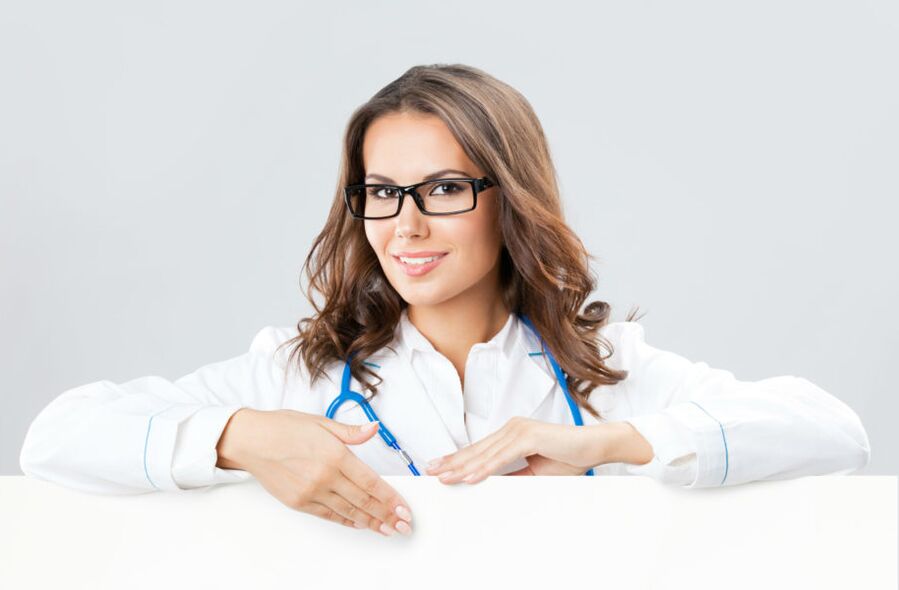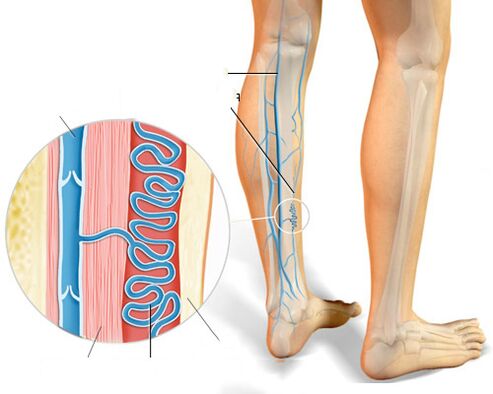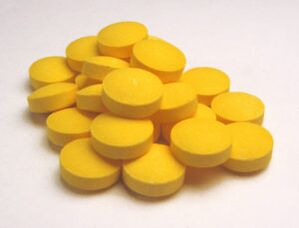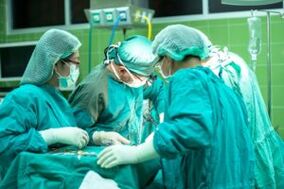
Varicose veins are a very common pathology that significantly reduces the quality of life and causes dangerous complications that require expensive and complex treatment.
What are varicose veins?
Varicose veins, or varicose veins, is a disease associated with a disorder of the valvular apparatus of the veins.As a result of their damage, the normal outflow of blood from the periphery is disturbed, and the blood stagnates in different parts of the vascular bed, causing them to expand.
The main population susceptible to this disease are people over 40 years old.This is due to the fact that by that time vessels are exposed to various negative influences, which causes a decrease in their ability to adapt.
Most often, varicose veins affect the lower extremities, but the pathological process can also be observed in the groin area or internal organs.
It is necessary to implement preventive measures, because this pathology has a tendency to progress, and the treatment regimen for varicose veins is quite complex.

Reasons
The main causes of varicose veins are considered excessive and insufficient mobility.The mechanism of normal blood flow through the veins is closely related to muscle contractions.During muscle tension, blood is pushed through the veins, and the valves located in the venous cavity prevent its return flow.
Lack of physical activity leads to congestion in the periphery, due to which the blood exerts excess pressure on the valve apparatus.Excessive stress also has a detrimental effect on the vascular system.Frequent muscle contractions can cause damage to the venous valves.
In addition, there are a number of negative factors and diseases that increase the risk of developing varicose veins:
- Bad habits.Alcohol and nicotine have vasomotor properties.They can expand and narrow the lumen of blood vessels, which causes disruption of normal blood flow.
- Abuse of coffee.
- Uncomfortable shoes.
- Genetic predisposition.
- Systemic connective tissue diseases.
- Atherosclerosis.
- diabetes mellitus.
- Traumatic lesions.
- Excess weight.
The presence of such factors greatly increases the risk of developing the disease.Regardless of the etiological factor, the symptoms of varicose veins of the lower extremities will not differ.
Clinical manifestations
Usually, the symptoms of this disease appear when there are already irreversible structural changes in the veins of the lower extremities.That is, the patient already needs surgical treatment at the time of contacting the doctor.

In the early stages, varicose veins can be asymptomatic.Some patients complain of minor pain that occurs after a long walk or run.There are no specific symptoms that would allow a diagnosis to be made.The initial forms of varicose veins can only be detected by instrumental examinations.
Symptoms of developed varicose veins are as follows:
- The appearance of cyanosis, which is localized along the veins.
- Veins protrude above the surface of the skin and form knots.These formations are painful and dense, which is associated with inflammation and the process of proliferation of connective tissue in those areas (sclerosis).
- Constant pain that does not depend on physical activity.If at the very beginning of the development of the pathology it occurs only after overexertion, then in the later stages it can disturb the patient even in sleep.This is due to the fact that one of the signs of inflammation is pain.The intensity of the pain can be quite strong, leading to lameness.
- Local temperature increase in the area of nodes.
The appearance of the first symptoms of the disease requires immediate contact with a medical facility for diagnosis and treatment.
Why are varicose veins dangerous?
The lack of proper treatment is fraught with the development of a series of dangerous complications that pose a threat not only to health, but also to life.This includes:
- Thrombophlebitis.In inflamed areas of veins, blood flow slows down significantly.Such conditions are favorable for the formation of blood clots.These blood clots can block the lumen of the vessels in the lower extremities, causing gangrene, or they can be carried with the blood to the lungs, heart, brain and other organs, causing an acute disruption of the blood supply.These pathologies are extremely difficult to treat and often lead to disability and death.
- Trophic ulcers.Violation of venous blood outflow is always accompanied by microcirculation disorders in the tissues of the lower extremities.Lack of oxygen and nutrients leads to ulceration.These ulcers are difficult to treat and often recur, because it is necessary to carry out therapy aimed at the cause of their occurrence.
- Bleeding.If varicose veins are accompanied by hypertension, it can lead to rupture of peripheral vessels and bleeding.This is due to the fact that dilated blood vessels become thinner, and high blood pressure can cause them to burst.In addition, bleeding can occur with minor mechanical damage, which in a healthy person will not even lead to the formation of a hematoma.
Almost all complications can be aggravated by the addition of an infectious factor, which significantly worsens the condition and complicates treatment.
If complications develop, the treatment of varicose veins should be reconsidered.
Diagnostics
If varicose veins are suspected, the patient must undergo a series of examinations, the purpose of which is to confirm the diagnosis, as well as to assess the condition of the tissue around the focus of the pathology.
To do this, it is recommended to perform the following checks:
- General blood test.
- Blood biochemistry.
- Coagulogram.This laboratory test allows predicting the development of thrombosis and thrombophlebitis, based on blood clotting properties.High coagulability is a dangerous condition.
- Ultrasound.Using ultrasound, you can get a detailed picture of the vascular bed and identify foci of inflammation that do not appear from the outside.
- Phlebography.Obtaining a graphic image of the venous system of the lower extremities using a contrast agent allows you to study its structures in detail and identify even the smallest changes.
In addition to instrumental and laboratory studies, specific tests are carried out that assess the state of soft tissues, and also assess the degree of circulatory failure.
An external examination is also important, during which the doctor can see specific external manifestations, probable localization and trophic ulcers.
A phlebologist should be involved in the treatment and supervision of patients with such a disease.It is this doctor who specializes in the treatment of varicose veins.
Treatment
Treatment of varicose veins of the lower extremities is possible using drugs or surgical procedures.The choice of treatment depends on how severe the changes are in the affected area.
Treatment of varicose veins of the lower extremities with drugs is carried out according to a special scheme, which takes into account the effect on the pathological process and prevents the development of complications.
Surgical treatment of varicose veins is the most effective, as it allows you to get rid of the pathology forever.However, it is not allowed for all patients and has a number of contraindications.
Conservative therapy

Treatment of varicose veins without surgery is allowed only in the early stages of the progression of the pathology.
It is worth remembering that conservative treatment only helps to eliminate the manifestations of the disease.It is impossible to achieve a lasting effect using only drugs.They work only for a certain time and are not able to prevent the progression of the disease.
Patients with varicose veins are advised to use the following groups of drugs:
- NSAIDs.It is recommended to use non-steroidal anti-inflammatory drugs locally, in the form of ointments. In some cases, it is possible to prescribe these drugs in the form of tablets, but long-term treatment can lead to the development of gastritis or peptic ulcers, which is caused by side effects.
- Antiaggregation agents.The action of such drugs is aimed at preventing blood clots.The primitive representative is considered to be ordinary aspirin, which is used in small doses.They thin the blood, making it easier for blood to flow through inflamed veins.The use of such drugs is unacceptable for patients who have a tendency to bleed.
- Hormones from the prednisolone group.In cases where NSAIDs do not have the desired effect, the use of adrenal hormones is indicated.These substances are also used in the form of ointments.They have a pronounced anti-inflammatory effect and improve tissue microcirculation.It is worth remembering that long-term use of hormones also has a harmful effect on the body's condition.
- Phlebotonics.This group of drugs is used in the treatment of varicose veins of the lower extremities.They normalize the tone of the vascular wall, which ensures normal blood flow.
Treatment of varicose veins should be systematic.Regular cyclic application of drugs allows you to maintain a constant concentration of active substances, which ensures a constant effect on damaged blood vessels.
The use of these drugs should only be as prescribed by the doctor.Their independent use is strictly prohibited, as they can cause side effects and also have specific contraindications.Failure to comply with such restrictions is fraught with deterioration of the general condition.
Conservative therapy is most suitable as an auxiliary method in preparation for the planned operation.
Surgical treatment

Many people are interested in how to cure varicose veins without surgery?In fact, it is impossible.The main type of surgical treatment is saphenectomy.
Saphenectomy is an operation whose purpose is to remove the damaged large veins of the saphenous vein.Thanks to this, the foci of the disease have been completely eliminated.But the lack of this treatment is a lot of trauma.In recent times, such operations were performed with a large number of incisions in the skin, which was necessary to allow access to the veins.
Today, modern methods of treating varicose veins make it possible to perform sephectomy with a minimal number of incisions, as there are special probes for vein extraction.A vein up to half a meter long can be removed with a single incision.
This operation has a number of contraindications that make it impossible to perform.This includes:
- diabetes mellitus.This pathology is accompanied by a significant reduction in wound healing.In such a situation, surgical intervention can cause purulent-septic processes, which may require limb amputation.
- Intolerance to antibacterial agents.In the postoperative period, antibiotics are prescribed that destroy the pathogenic flora that entered the wound during surgical treatment.Some patients have intolerance to such drugs.Surgical treatment without antibiotic therapy is strictly prohibited.
- Severe diseases of the cardiovascular system.Those pathologies that are accompanied by heart failure can become a contraindication, as the use of certain anesthetics is prohibited for them.
Saphenectomy is performed in uncomplicated forms of varicose veins.Those cases in which trophic ulcers or necrotic changes caused by an acute blood supply disorder are observed require an expansion of the scope of the operation.
It is possible to excise ulcers during surgery.In this way, tissue death is prevented.In cases where venous thrombosis has led to gangrene, amputation is necessary.This operation is performed only in extreme cases.
There are also modern minimally invasive treatment methods, including:
- Sclerotherapy.
- Radiofrequency ablation.
- Laser ablation.
These treatment methods are based on the occlusion of the lumen of blood vessels and their further destruction by chemical or physical factors.
It is recommended to use them in the early stages of the disease.In such a situation, the risk of relapse becomes minimal.It is not worth using such a treatment for advanced varicose veins, as it may require quite a large number of sessions.
Folk remedies
Some sources suggest the use of various traditional medicines as a treatment for varicose veins.This is strictly not recommended, because the effect of plants in this pathology has not been scientifically confirmed.
Treatment of varicose veins on the lower extremities should be planned exclusively by an authorized medical specialist.Methods for treating varicose veins without surgery only help to delay its application.You should not turn to various folk healers, because the lost time before proper treatment can lead to amputation.
Concomitant therapy
In order to achieve the maximum effect of the treatment, it is necessary to carry out additional measures along with the use of drugs.This includes:
- Diet.Patients with varicose veins should avoid fatty foods.It helps to increase cholesterol levels and blood viscosity.Such processes lead to an increased slowing of peripheral blood circulation in the area of varicose veins and cause the formation of thrombus.In addition, you need to drink plenty of fluids to thin the blood.It is recommended to drink plain water, not carbonated drinks or tea.
- Occasionally secure the legs in an elevated position.Such procedures stimulate blood flow under its own weight, which prevents stagnation.
- Wearing compression stockings.In the upright position of the body, such socks prevent the accumulation of blood in varicose veins.But such socks must be used properly, because long-term wearing can negatively affect the condition of the feet, as well as the skin in the lower leg area.
- Walks.Patients must lead an active lifestyle.In the later stages of varicose veins, walks should be short and should not cause fatigue or pain in the legs.
In addition, it is necessary to treat accompanying pathologies such as atherosclerosis, diabetes mellitus or obesity.The presence of such therapy allows in some cases to be limited only to drug treatment, which ensures a favorable outcome of the disease.
Prevention

In order to prevent the development of varicose veins, you must follow a series of simple rules that will reduce the risk of its occurrence.All of them are aimed at maintaining normal blood properties, as well as creating a normal lifestyle.Among them are:
- Drink at least one and a half liters of fluid a day.
- Proper nutrition.This term implies not only the provision of all necessary substances in the diet and the exclusion of harmful foods, but also regular meals.Eating at the same time allows you to get the maximum amount of nutrients from food, because the reflex develops and a sufficient amount of gastric juice is released.
- Getting rid of bad habits.
- Limit the amount of coffee and other energy drinks.
- Ensure mobility even when working seated.There are special exercises for that, the purpose of which is to tighten the leg muscles.
- Timely treatment of diseases.Any pathology in the human body can cause long-term consequences.To avoid this, you should always seek medical help if any symptoms appear, and also undergo preventive examinations.
Today, there are different ways to treat varicose veins.With a timely diagnosis, they allow you to get rid of the problem once and for all.Treatment of varicose veins without surgery is recommended only at the very beginning of the disease.
